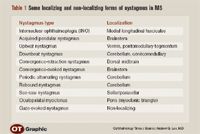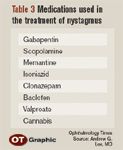Article
Nystagmus can be the presenting sign of multiple sclerosis
Multiple sclerosis (MS) can present to the ophthalmologist with visual loss (e.g., opticneuritis), diplopia (e.g., internuclear ophthalmoplegia [INO] or sixth-nerve palsy), or nystagmus.

Some localizing and non-localizing forms of nystagmus seen in MS are listed in Table 1. An INO is characterized by an ipsilateral adduction deficit and a contralateral abducting dissociated horizontal nystagmus on horizontal gaze. In a young patient, a new INO should be considered to represent MS until proven otherwise. The lesion involves the medial longitudinal fasciculus (MLF), the interneuron between the sixth- and third-nerve nuclei. Careful attention to the horizontal saccades might bring out a subtle INO. Table 2 lists some common features of the INO.

Jerk beating nystagmus is named for the fast phase (e.g., fast phase down = beating nystagmus). Downbeat nystagmus typically worsens in downgaze and lateral gaze and localizes to the cervicomedullary junction. Upbeat nystagmus localizes to the pontomedullary junction or in some cases the cerebellar vermis. Periodic alternating nystagmus (PAN) demonstrates a horizontal fast phase in one direction, followed by a slowing of the nystagmus, a null phase with minimal or no eye movement, and then the nystagmus alternates with the fast phase toward the opposite direction. Acquired pendular nystagmus has an equal amplitude and frequency in both directions and is a relatively common finding in MS.

Summary Ophthalmologists should be aware that nystagmus can be the presenting or only sign of MS. The abducting nystagmus of the INO and acquired pendular nystagmus are common nystagmus presentations. Cranial MRI with contrast enhancement is the procedure of choice for evaluating nystagmus. Optical, medical, and surgical treatments might help selected patients.
G. Lee, MD, is editor of The Neuro-Connection. He is a professor of ophthalmology, neurology, and neurosurgery at the University of Iowa Hospitals and Clinics, Iowa City.
References 1. Averbuch-Heller L. Acquired nystagmus. Curr Treat Options Neurol 1999;1:68-73.
2. Bandini F, Castello E, Mazzella L et al. Gabapentin but not vigabatrin is effective in the treatment of acquired nystagmus in multiple sclerosis: How valid is the GABAergic hypothesis? J Neurol Neurosurg Psychiatry 2001;71:107-110.
3. Barton JJ, Cox TA. Acquired pendular nystagmus in multiple sclerosis: clinical observations and the role of optic neuropathy. J Neurol Neurosurg Psychiatry 1993;56:262-267.
4. Barton JJ, Cox TA, Digre KB. Acquired convergence-evoked pendular nystagmus in multiple sclerosis. J Neuroophthalmol 1999;19:34-38.
5. Dell'Osso LF. Suppression of pendular nystagmus by smoking cannabis in a patient with multiple sclerosis. Neurology 2000;54:2190-2191.
Newsletter
Don’t miss out—get Ophthalmology Times updates on the latest clinical advancements and expert interviews, straight to your inbox.





